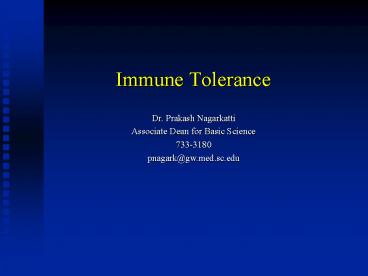Immune Tolerance - PowerPoint PPT Presentation
1 / 22
Title:
Immune Tolerance
Description:
Tolerance--- specific unresponsiveness triggered by previous exposure to Ag. ... Burnet's Hypothesis:(1949) Tolerance. Medawar proves Burnet's Hypothesis: The ... – PowerPoint PPT presentation
Number of Views:689
Avg rating:3.0/5.0
Title: Immune Tolerance
1
Immune Tolerance
Dr. Prakash Nagarkatti Associate Dean for Basic
Science 733-3180 pnagark_at_gw.med.sc.edu
2
Self-nonself discrimination
Non-self or foreign
Self
No response
Strong response
3
Tolerance
- Tolerance---gtspecific unresponsiveness triggered
by previous exposure to Ag. - Natural Tolerance (self tolerance)
Unresponsiveness to self Ags. - Acquired tolerance
- Unresponsiveness to foreign Ags.
4
Tolerance
Tolerance in non-identical cattle twins
5
Tolerance
Burnets Hypothesis(1949)
- During neonatal stage of life, or when immune
system is developing, all Ags present are
recognized as self. - Immune system becomes tolerant to these Ags.
- How is tolerance accomplished?
- By clonal deletion--cells which come across
self-Ag undergo apoptosis.
6
Tolerance
Medawar proves Burnets Hypothesis
The above result was specific.
- Burnett Medawar won Nobel Prize in 1960.
7
Mouse Chimera
8
Radiation Bone-marrow Chimeras
A
1000R
B
Lymphoid cells--gt strain A
B
Non lymphoid---gt strain B
This procedure is used in cancer patients.
9
Tolerance
- Why is it imp. to study tolerance?
- Autoimmunity
- Cancer
- Transplantation
- Infections
- Vaccines
10
Factors affecting tolerancerole of antigen
Physical form of antigen
Large, aggregated, complex molecules
soluble, aggregate-free, simple small molecules
Antigen processing
properly processed
improperly processed
Subcutaneous or intra-muscular
Oral or, sometimes, intravenous
Route of injection
Very large or very small dose
Optimal dose
Dose of antigen
11
Factors affecting tolerancerole of antigen
Age of responding animal
Adult, immunologically mature
Newborn (mice) Immunologically immature
Fully differentiated, Memory
Differentiation state of cells
Undifferentiated B cell with only IgM, T cells in
the thymic cortex
12
Mechanisms of tolerance
- There are multiple mechanisms of tolerance.
- Clonal deletion.
- Regulatory T cells (formerly called suppressor T
cells). - Anti Idiotypic Abs.
13
T cell Development in the thymus
Dendritic cells
Cortical epithelium
MHC Class I and II
High TCR
V
Low TCR
V
CD4
CD4
CD4-CD8-TCR-
CD8
V
TCR
BM Stem cell
Thymocyte
CD8
Mature T cell
Negative selection
Positive selection
14
Regulatory T cells
- Several different regulatory T-cell subsets have
been described. - The CD4 regulatory T cells have been categorized
into two major subgroups - Forkhead box P3 (Foxp3)CD4CD25 regulatory T
cells which develop in the thymus and are present
in normal mice and healthy individuals from birth
- Inducible regulatory T cells, which are generated
in the periphery under various tolerogenic
conditions.
15
Foxp3
- Foxp3, an X chromosomeencoded forkhead
transcription factor family member, is
indispensable for the differentiation of
regulatory T cells. - Genetic mutations in Foxp3 in humans leads to
development of a severe and rapidly fatal
autoimmune disorder known as Immune
dysregulation, Polyendocrinopathy, Enteropathy,
X-linked (IPEX)syndrome. - Foxp3 mutations lead to massive
lymphoproliferation, diabetes, exfoliative
dermatitis, thyroiditis and enteropathy.
16
Regulatory T cells
- Defective regulatory T cells in genetic diseases
- Patients with WiskottAldrich syndrome,
autoimmune polyglandular syndrome type 2 and
autoimmune lymphoproliferative syndrome are the
few autoimmune diseases caused by known genetic
defects. These patients have also defects in
regulatory T cells. - Regulatory T cells can be used in the treatment
of autoimmune diseases in future.
17
Regulatory cells
- The precise mode of action of regulatory T cells
is not clear. - Cell-cell contact and soluble factors such as
IL-10 or TGF-ß play a role. - Regulatory T cells play a crucial role in oral
tolerance. Ex Colitis can be prevented by
transfer of regulatory T cells.
18
Role of anti-idiotypic Ab in tolerance.
Anti-idiotype
Ag
epitope
Idiotype
19
Activation-induced Cell Death(AICD)
Plays a key role in peripheral T cell
tolerance. Defiency of Fas or FasL triggers
Lympho- Proliferative Disease.
20
Defect in Fas or FasL triggers Autoimmunity
Fas
Fas
Fas-
Normal
Fas L
Fas
Autoimmunity and lymphoproliferative disease
Fas L
21
Summary
- Immune system recognizes both self and non-self.
- Immune tolerance is a specific mechanism through
which the host tries to evade responding to
self-Ags. - Clonal deletion and Regulatory T cells are the
primary mechanisms. - Breakdown of tolerance leads to autoimmune
disorders.
22
Thank you































![[PDF] Oral Tolerance: Cellular and Molecular Basis, Clinical Aspects, and Therapeutic Potential (Medical Intelligence Unit) 2004th Edition Free PowerPoint PPT Presentation](https://s3.amazonaws.com/images.powershow.com/10084220.th0.jpg?_=20240723105)